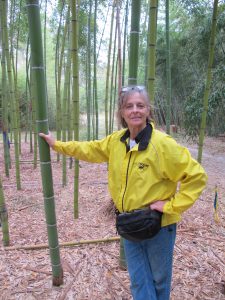To select bamboos for your farm, go to the American Bamboo Society website. Find the Chapter nearest to you. Meet LOCAL members. Visit their collections. Join the Society.

Daphne Lewis’ mission is to add bamboo to American agriculture. In 2010 she moved to Georgia from Washington State to research bamboo. She laid out 1000 square foot research plots in existing bamboo groves that were mature. The yield data from the first three years were disappointing. A major factor was that she could not irrigate the groves. Therefore in 2013, Daphne bought acreage with a good well. In 2014 she installed irrigation and planted eleven varieties of bamboo in twelve separate research plots. Most plots measure 100 by 130 feet.
Sir Ernest Satow (Tokio 1899) writes:
“The origin of the word bamboo…was obscure. Colonel Yule, in his delightful “Glossary of Anglo-Indian words”, thought we got it through the Portuguese from a Canarese word bamuu. The earliest Portuguese writer called it mambu, and its first occurrence in English was in Hakluyt’s Voyages (1586) in the form Bambo. By the time of Purchas, in 1621, it had assumed its present form Bamboo.”
Established agricultural products like pecans, peanuts, or chickens have a support infrastructure. They are part of an industry of suppliers, distributors, and retailers supported by government research and even government loans. This support infrastructure does not exist for bamboo. You can not take your bamboo poles to a mill to be made into ply-bamboo, for example. Produce buyers (usually) will not buy your bamboo shoots. To be a bamboo farmer, you need both to create your market and to use the bamboo on your farm. On your farm, use your bamboo for fodder, erosion control, windbreaks, shading-and-cooling, and for chips. Sell your shoots to a high end restaurant, at farmers’ markets, or on-line. Make pickles.
Chip your poles, bag the chips and sell them as mulch. Make charcoal. Groom your groves to be elegant and rent them for events.